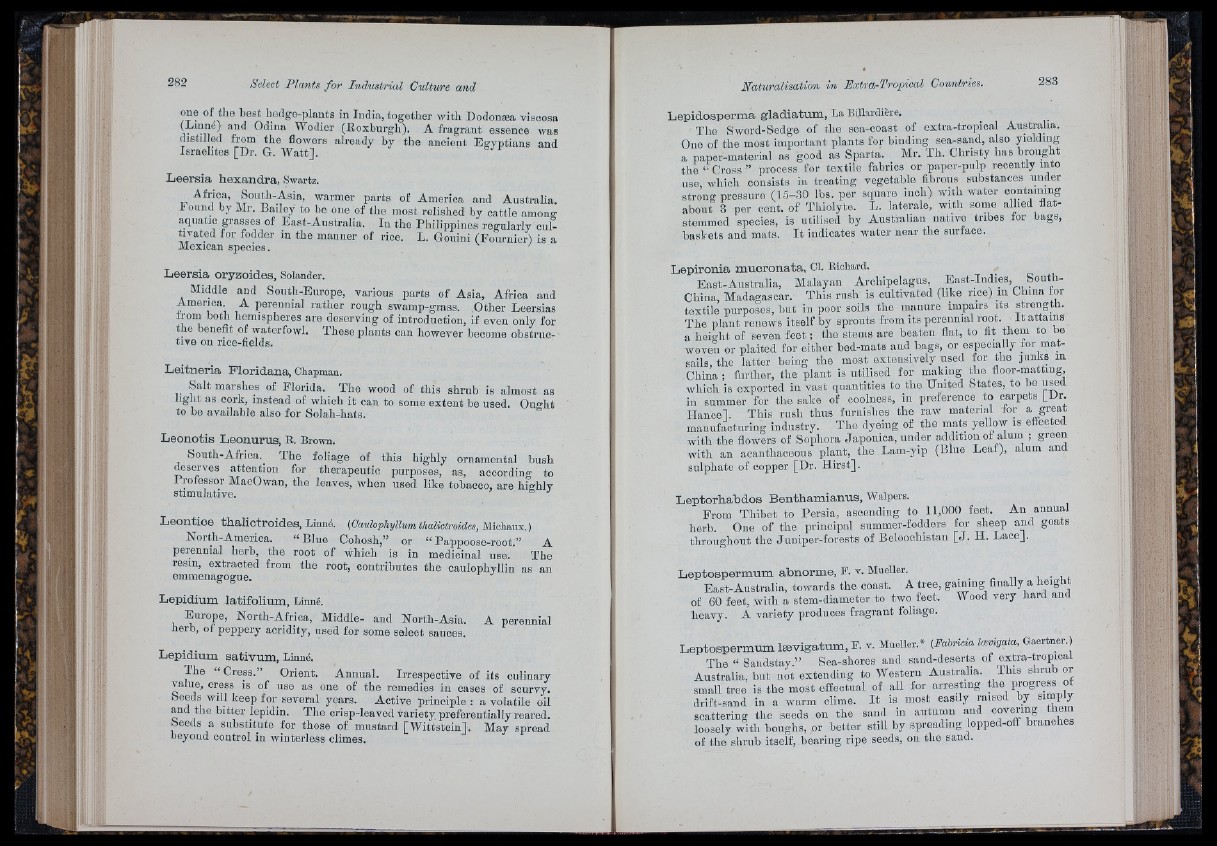
¡ i
' i
Î' ■ !
one of the best hedge-plants in India, together with Dodonæa viscosa
Odina VVodier (Roxburgh). A fragrant essence was
distilled from the flowers already by the ancient Egyptians and
Israelites [Dr. G. Wa tt].
Leersia hexandra, Swartz.
Africa, South-Asia, warmer parts of America and Australia.
Found by Mr. Bailey to be one of the most relished by cattle among
aquatic grasses of East-Australia. In the Philippines regularly ciil-
tivated for fodder in the manner of rice. L. Goiiini (Fournier) is a
Mexican species.
Leersia oryzoides, Solander,
Middle and South-Europe, various parts of Asia, Africa aud
America. A perennial ratlier rough swamp-grass. Other Leersias
trom both hemispheres are deserving of introduction, if even only for
the benefit of waterfowl. These plants can however become obstructive
on rice-fields.
Leitneria Ploridana, Chapman.
Salt marshes of Florida. The wood of this shrnb is almost as
light as cork, instead of whicli it can to some extent be nsed. Ought
to be available also for Solah-hats.
Leonotis Leonurus, R. Brown.
Sonth-Africa._ The foliage of this highly ornamental bush
deserves attention for therapeutic purposes, as, according to
Iio te sso r MacOwan, the leaves, when used like tobacco, are highly
stimulative. ■'
Leontioe thalictroides, Linné. (Gaulophyllumthalictroides, Michaux.)
North-America. “ Blue Cohosh,” or “ Pappoose-root.” A
perennial herb, the root of which is in medicinal use. The
resm, extracted from the root, contributes the canlophyllin as an
emmenagogue.
Lepidium latifolium, Linné.
Europe, North-Africa, Middle- and North-Asia.
herb, of peppery acridity, nsed for some select sauces.
A perennial
Lepidium sativum, Linné.
I h e “ Cress.” Orient. Annual. Irrespective of its culinary
value, cress is of use as one of the remedies in cases of scurvy,
heeds will keep for several years. Active principle : a volatile oil
and the bitter lepidin. The crisp-leaved variety preferentially reared,
heeds a substitute for those of mustard [W ittste in ]. May spread
beyond control in winterless climes.
L e p id o s p e rm a g l a d i a tu m . La Biliardière.
The Sword-Sedge of the sea-coast of extra-tropical Australia.
One of the most important plants for binding sea-sand, also yielding
a paper-material as good as Sparta. Mr. Th. Christy has brought
the “ Cross ” process for textile fabrics or paper-piilp recently into
nse, which consists in treating vegetable fibrous sulistances under
strong pressure (15-30 lbs. per square inch) with water containing
about 3 per cent, of Thiolyte. L. laterale, with some allied flatstemmed
species, is utilised by Australian native tribes for bags,
baskets and mats. I t indicates water near the surface.
L e p i r o n i a m u c r o n a t a , Cl. Richard.
East-Australia, Malayan Archipelagus, East-Indms, South-
China, Madagascar. This rush is cultivated (like rice) iii China for
textile purposes, but in poor soils the manure impairs its strength.
The plant renews itself by sprouts from its perennial root. I t attains
a height of seven feet ; the stems are beaten flat, to fit them to be
woven or plaited for either hed-mats and bags, or especmlly lor mat-
sails, the latter being the most extensively nsed for the Jimks in
Cliina ; further, the plant is utilised for making the floor-mattmg,
which is exported in vast quantities to the United States, to be used
in summer for the sake of coolness, in preference to carpets (D r
Hance]. This rush thus furnishes the raw material for a great
manufacturing industry. The dyeing of the mats yellow is eflfected
with the flowers of Sophora Japónica, under addition of alum ; green
with an acanthaoeous pla,nt, the Lam-yip (Blue Leaf), alum and
sulphate of copper [Dr. Hirst].
L e p t o r h a b d o s B e n th a m i a n u s . Walpers.
From Thibet to Persia, ascending to 11,000 feet. An annual
herb. One of the principal siimmer-fodders for sheep and goats
throughout the Juniper-forests of Beloochistau [ J . H. Lace].
L e p t o s p e rm u m a b n o rm e , F. v. Mueller. , • . ,
East-Australia, towards the coast. A tree, gaimng finally a height
of 60 feet, with a stem-diameter to two feet. Wood very hard anc
heavy. A variety produces fragrant foliage.
L e p t o s p e rm u m læ v ig a tu m , F. v. Mueller.* (Fahricia lævigata, Gaertner.)
The “ Sandstay.” Sea-shores and sand-deserts of extra-tropical
Australia, but not extending to Western Australia. I ins shrub or
small tree is the most effectuai of all for arresting ffle progress ot
drift-sand in a warm clime. I t is most easily raised by simp y
scattering the seeds on the sand in aiitiiran and covering them
loosely with boughs, or better still by spreading lopped-oflf blanches
of the shml) itself, bearing ripe seeds, on the sand.